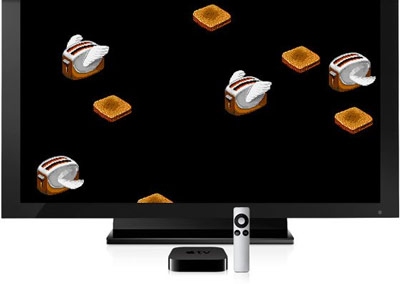Here’s the trouble with “Apps as TV channels”
 One of Apple’s big opportunities to reinvent TV is to change how shows are distributed. So far, it has had modest success with iTunes TV downloads, but little beyond that: iTunes TV “rentals” never took off, and Apple seems to have failed to put together a subscription TV service so far.
One of Apple’s big opportunities to reinvent TV is to change how shows are distributed. So far, it has had modest success with iTunes TV downloads, but little beyond that: iTunes TV “rentals” never took off, and Apple seems to have failed to put together a subscription TV service so far.
One potential design, as recently highlighted by John Gruber, Jason Kottke, and David Chartier, is the idea of “apps as TV channels.” (I also outlined some Apple TV apps I’d love to see about a year ago, including the return of the classic Mac Flying Toasters screensaver.)
In this model, Apple could provide the platform — iOS running on a new Apple iTV television set — and allow media companies to build apps as their new channels. It’s taking the model that Apple just launched with Newsstand, but applying it to the big screen.
Why not the same thing for TV channels? We’re seeing the beginnings of this, with iPhone and iPad apps like HBO Go, Watch ESPN, and the aforementioned Bloomberg TV+. Letting each TV network do their own app allows them the flexibility that writing software provides. News networks can combine their written and video news into an integrated layout. Networks with contractual obligations to cable operators, like HBO and ESPN, can write code that requires users to log in to verify their status as an eligible subscriber.
As a user, this could be excellent — potentially gaining access to more content, a better user interface, and new features that haven’t even been imagined yet. I wouldn’t have to remember that Cooking Channel is “751” anymore, or spend half an hour trying to find HBO On Demand.
For Apple, it would obviously be a winner — besides offering an exclusive, differentiated TV experience, it could funnel subscriptions through its iTunes store and take a cut.
And for media companies, in theory, this is a better future. It wouldn’t be selling directly to its audience, but it would be closer than going through the cable middlemen. And the imaginative ones could blossom way behind the technical limitations currently imposed by cable and satellite TV companies.
But here’s the problem: The people running TV networks are not dummies. They may be slow to adopt new technology, but they’re not stupid. They saw how the music industry lost control of itself. And they are set on making sure that if Internet distribution and new technologies eventually redraw the entire TV distribution chain, it happens on their terms and on their schedule.
Basically: It’s all about preserving their existing business models. This sounds lame, but it’s reality. And because top-quality content is actually very hard and expensive to make, and is therefore scarce, they’ve actually been able to do this effectively.
- For now, that means working very closely with today’s cable, satellite, and telco TV providers. Why? Not because these companies are necessarily fun to work with. Because they still write massive checks to the networks for their content. These “affiliate fees” can represent the majority of a cable network’s revenue, even if they sell a lot of advertising.
- Even if Apple can deliver the same — or higher — affiliate fee on a per-subscriber basis, it will probably be a long time before the aggregate checks from Apple are big enough to justify pissing off a big, existing partner. (Unless Apple dips deep into its huge cash pile to grease the networks. But that doesn’t seem like Apple’s style. And that might need to be a lot of cash to get the wheels turning.)
- For the networks, not pissing off the cable guys means staying away from putting too much digital video on TV sets, especially for free. iPhone and iPad apps aren’t as bad. And yes, the geeks among us have been plugging their laptops into their TVs for years. But putting stuff on a TV set in a way that’s easy for normal people to access — and in a way that competes with traditional TV — is still a no-no for most networks. Especially the ones that are more dependent on affiliate fees, or hope to make the argument for higher affiliate fees in the future. This is one reason that TV networks have blocked Google TV from accessing their content. And why many iPad video apps don’t let you beam the video to your Apple TV via AirPlay.
- Some TV providers have established “authentication” or “TV Everywhere” services that let you log in with your cable credentials to watch video, such as the ESPN and HBO Go iPad apps, which Gruber mentions. (And many of Apple’s Newsstand magazine apps support this concept for print subscribers.) But today, these only work with certain TV apps and certain cable/satellite providers — there’s no standard across the industry yet. This may be Apple’s best opportunity to start, though, if Apple can get over the idea that cable providers are intimately involved in the process.
So what’s the solution? Unless Apple can somehow buy itself some huge, ground-breaking deals, it may have to start small.
That might mean building out the “Apps as channels” platform and hoping that an audience and the TV networks eventually show up. (Perhaps with the early participation of a few smaller and non-traditional networks like Bloomberg, MLB, etc. Don’t forget how Bloomberg makes money — by renting financial data/news terminals to Wall Street, not from its TV network.)
It may even mean supporting existing cable TV service, which will become easier as more cable providers test and deploy TV service using Internet protocol. This allows devices like an Apple TV, Microsoft Xbox 360, etc., to basically become a virtual cable set-top box with a custom user interface, without using old-school CableCards.
While the “apps as channels” model sounds like a great one — and is probably a rough idea of what the future of TV looks like — it doesn’t seem like something that is going to show up and take off as quickly as iOS video apps have, or even as fast as the new Apple Newsstand. At least not among the big, traditional networks that still produce and broadcast most of the content people want to watch. Unless, of course, Apple starts writing some really big checks.
Related: Here’s why Apple’s TV needs to be an actual television, and not just a cheap add-on box

Check out my new site: The New Consumer, a publication about how and why people spend their time and money.

